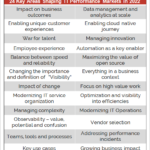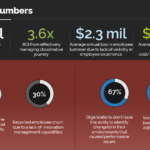Digital Enterprise Journal (DEJ) just published a new state of the market study, 24 Key Areas Shaping IT Performance Markets in 2022. The study is based on insights from more than 3,300 organizations around a variety of topics about managing IT performance.
more than 3,300 organizations around a variety of topics about managing IT performance.
This research article summarizes some of the key findings from this research.
Technology as a business advantage is not optional
The study shows a 41% increase in “enabling new and unique customer experiences” as the key driver for investing in IT performance technologies over the last 18 months. Additionally, organizations reported $7.63 million, on average, annual loss due to the inability to align software delivery initiatives to business outcomes.
Organizations are understanding the benefits of digital transformation, however, many of them didn’t have a sense of urgency for putting technology in the core of business strategies. The study shows that organizations that fall behind their competitors when it comes to modernization and using technology to create a business value are experiencing rapid declines of their competitive positions. The business pressures are causing organizations to understand that using technology to create differentiating customer experiences is no longer optional and that it requires changes to their mindset, strategies, technology capabilities and processes.
The #1 capability needed – correlating IT performance to business outcomes
DEJ used our unique distributed survey data collection approach to identify the importance of hundreds of technology capabilities. Staggering 84% of organizations selected “correlating IT performance to business outcomes” as a capability they are looking to deploy. It should be noted that there is a number of solutions in the market that provide some business context when it comes to managing IT performance. What organizations are really looking for is a capability that connects the dots between operational improvements and business outcomes in a clear and measurable way. Therefore, the study shows a 32% increase in the number of organizations that are using “ability to quantify the business impact” as the key selection criteria over the last 18 months.
Understanding the importance of managing talent
The study found that skills gap is the #1 challenge for adopting a cloud native approach. The research also shows that 68% of an IT team’s time is spent on tasks that do not contribute to key business outcomes. Additionally, the study shows that organizations are losing, on average, $2.82 million annually because of employee turnover due to lack of visibility in employee experience.
Recruiting and retaining the right talent, aligning people resources with business goals, reducing time spent on addressing performance incidents and visibility into technology adoption by employees are some of the key focus areas, reported organizations. That also impacts requirements for technology adoption as 57% organizations see automation as the key enabler for closing the modernization skills gap in managing IT Operations.

Data capabilities as the answer to key challenges
The study shows that data management and analytics capabilities are key focus area when it comes to addressing top initiatives such as enabling unique customer experiences, managing complexity, innovation management and modernizing IT service delivery organization. Thirty-eight percent of organizations reported improving their data management and analytics capabilities as the key area for improvement when looking to create business value from technology deployments.
Additionally, the study shows that forward-thinking organizations are aware that improving in this area requires a mix of different capabilities and a strategic approach. As a result, these organizations are 3.7 times more likely to improve customer engagement and experience.
Growing business impact
DEJ’s comparison with the findings of the 2020 state of market study found that the business impact of IT performance is constantly growing and at a high rate. The study shows $935,000 increase in average annual revenue loss due to engineers not focusing on business critical tasks over the last 12 months (28% increase).
Additionally, reliability and quality of user experience for digital services are becoming more important for achieving business goals as the study shows significant increases in a cost on downtime and cost of not acting around user management.
Importance of managing cloud native and hybrid cloud environments
The study identified a number of use cases whose importance increased over the last 2 years. As organizations are increasingly realizing the importance of continuously innovating and being able to respond to changing business needs faster, the research shows a 76% increase in the importance of Kubernetes management and a 59% increase in the importance of enabling cloud native journey.
Managing hybrid cloud was reported as one of the top use cases in the 2020 study and this year’s research shows that ever more organizations are looking for capabilities for managing this type of environment. The study shows a 66% increase in the importance of managing hybrid cloud.

Aligning teams, tools and processes as a key requirement
Fifty-nine percent of organizations identified collaboration and workflows as the key areas for improvement. Additionally, the study reveals a 31% increase in the number of organizations that are looking to deploy capabilities for continuous learning from previous incidents over the last 18 months. Lastly, engineering leaders are 44% more likely to report a lack of processes as the key area for improvement as compared to a lack of tools.
New user requirements for managing IT performance also come with an introduction of new metrics and increasing need for aligning teams, tools and processes. The study shows that organizations that are effective in this area are experiencing a 56% average improvement in customer satisfaction.
Intelligence and automation, a powerful combination for driving a business value
Seventy percent of organizations reported a balance between resource utilization and performance as a key focus area. However, 68% of organizations do not have visibility into how their IT resources are being used while 56% reported a lack of AI, Ml and context-based automation capabilities as a key challenge for maximizing the value of their IT resources.
Organizations need to deploy capabilities that would allow them to have visibility into inefficiencies and apply intelligent automation to continuously optimize resource utilization and performance.
Cost of not acting
The study shows that ineffectiveness in managing IT performance is not only impacting new business areas, but also the magnitude of that impact is continuously growing. The study reveals a $46 million average annual loss due to a lack of automation capabilities for managing IT performance (release delays, incident prevention and resolution, etc.). Additionally, organizations reported a $13.74 million average annual business loss (revenue loss and/or increased cost) due to a lack of talent for modernization.
DEJ’s 2021 study, The Total Business Impact of IT Performance revealed that there are many segments of IT performance that impact the business (some more and some less), but when added all together the impact is enormous. This new study shows that the business impact is constantly growing and expanding to new areas.
The study can be accessed on DEJ’s website through this link. The complementary version can be downloaded on the websites of vendors that own distribution rights to the study: Catchpoint, Mezmo, Micro Focus, OpsRamp.



